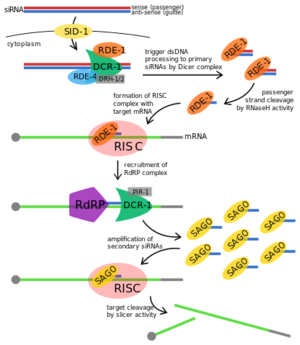Sandbox RDE-1
From Proteopedia
(→Introduction) |
|||
| Line 1: | Line 1: | ||
== Introduction == | == Introduction == | ||
<Structure load='4krf' size='350' frame='true' align='right' caption='Protein length: 1020 aa, Mass: 118,804 Da' scene='Insert optional scene name here' /> | <Structure load='4krf' size='350' frame='true' align='right' caption='Protein length: 1020 aa, Mass: 118,804 Da' scene='Insert optional scene name here' /> | ||
| - | The rde-1 gene | + | The rde-1 gene is a member of the ''Argonaute'' gene family. Proteins from "Argonaute" family form an evolutionarily conserved family whose members silence gene expression in pathways such as RNA interference (RNAi). Argonaute family proteins can be divided into two types, AGO and PIWI proteins, depending on the small RNA they bonded to. Both types of Argonaute proteins bind 21–35 nucleotide-long small RNA guides whose sequence identifies the genes to be silenced. <ref>https://www.sciencedirect.com/science/article/pii/S0960982211005471</ref> |
| - | + | '''RDE-1''' (RNAi-DEfective 1), a primary Argonaute protein, is required for RNA-mediated interference in ''Caenorhabditis elegans''; thus, it is also known as RNAi promoting factor. Its gene locus was first characterized in ''C. elegans'' mutants resistant to RNAi, and was found to be a member of the PIWI gene family that includes plant, Drosophila, and vertebrate homologs. <ref>Tabara, H.; Sarkissian, M.; Kelly, W. G.; Fleenor, J.; Grishok, A.; Timmons, L.; Fire, A.; & Mello, C. C. (Oct 1999). "The rde-1 gene, RNA interference and transposon silencing in C. elegans". Cell. 99 (2): 123–32. doi:10.1016/S0092-8674(00)81644-X. PMID 10535731</ref> | |
== Structure == | == Structure == | ||
Canonical Argonaute proteins possess three primary domains forming a crescent-shaped base: the PAZ, MID, and PIWI domains. PAZ and MID orient and anchor the double-stranded siRNA by binding to the 3’ and 5’ termini, respectively, leaving the internal nucleotides accessible for base pairing. The PIWI domain folds into an RNase H-like structure, and contains the conserved catalytic triad “DDH” (two aspartate residues, one histidine residue). The crystal structure of RDE-1 has not been formally elucidated, but can be assumed to closely resemble its human homologs. | Canonical Argonaute proteins possess three primary domains forming a crescent-shaped base: the PAZ, MID, and PIWI domains. PAZ and MID orient and anchor the double-stranded siRNA by binding to the 3’ and 5’ termini, respectively, leaving the internal nucleotides accessible for base pairing. The PIWI domain folds into an RNase H-like structure, and contains the conserved catalytic triad “DDH” (two aspartate residues, one histidine residue). The crystal structure of RDE-1 has not been formally elucidated, but can be assumed to closely resemble its human homologs. | ||
| - | RDE-1 protein consists of 1020 amino acids. <ref> | + | RDE-1 protein consists of 1020 amino acids. <ref>Tabara, H.; Sarkissian, M.; Kelly, W. G.; Fleenor, J.; Grishok, A.; Timmons, L.; Fire, A.; & Mello, C. C. (Oct 1999). "The rde-1 gene, RNA interference and transposon silencing in C. elegans". Cell. 99 (2): 123–32. doi:10.1016/S0092-8674(00)81644-X. PMID 10535731</ref> |
== Importance/Function == | == Importance/Function == | ||
Revision as of 22:18, 8 October 2018
Contents |
Introduction
|
The rde-1 gene is a member of the Argonaute gene family. Proteins from "Argonaute" family form an evolutionarily conserved family whose members silence gene expression in pathways such as RNA interference (RNAi). Argonaute family proteins can be divided into two types, AGO and PIWI proteins, depending on the small RNA they bonded to. Both types of Argonaute proteins bind 21–35 nucleotide-long small RNA guides whose sequence identifies the genes to be silenced. [1] RDE-1 (RNAi-DEfective 1), a primary Argonaute protein, is required for RNA-mediated interference in Caenorhabditis elegans; thus, it is also known as RNAi promoting factor. Its gene locus was first characterized in C. elegans mutants resistant to RNAi, and was found to be a member of the PIWI gene family that includes plant, Drosophila, and vertebrate homologs. [2]
Structure
Canonical Argonaute proteins possess three primary domains forming a crescent-shaped base: the PAZ, MID, and PIWI domains. PAZ and MID orient and anchor the double-stranded siRNA by binding to the 3’ and 5’ termini, respectively, leaving the internal nucleotides accessible for base pairing. The PIWI domain folds into an RNase H-like structure, and contains the conserved catalytic triad “DDH” (two aspartate residues, one histidine residue). The crystal structure of RDE-1 has not been formally elucidated, but can be assumed to closely resemble its human homologs. RDE-1 protein consists of 1020 amino acids. [3]
Importance/Function

Disease
Relevance
This is a sample scene created with SAT to by Group, and another to make of the protein. You can make your own scenes on SAT starting from scratch or loading and editing one of these sample scenes.
</StructureSection>
References
- ↑ https://www.sciencedirect.com/science/article/pii/S0960982211005471
- ↑ Tabara, H.; Sarkissian, M.; Kelly, W. G.; Fleenor, J.; Grishok, A.; Timmons, L.; Fire, A.; & Mello, C. C. (Oct 1999). "The rde-1 gene, RNA interference and transposon silencing in C. elegans". Cell. 99 (2): 123–32. doi:10.1016/S0092-8674(00)81644-X. PMID 10535731
- ↑ Tabara, H.; Sarkissian, M.; Kelly, W. G.; Fleenor, J.; Grishok, A.; Timmons, L.; Fire, A.; & Mello, C. C. (Oct 1999). "The rde-1 gene, RNA interference and transposon silencing in C. elegans". Cell. 99 (2): 123–32. doi:10.1016/S0092-8674(00)81644-X. PMID 10535731
- ↑ https://en.wikipedia.org/wiki/RDE-1#/media/File:Exogenous_RNAi_Pathway_in_C._elegans,_edited.svg
